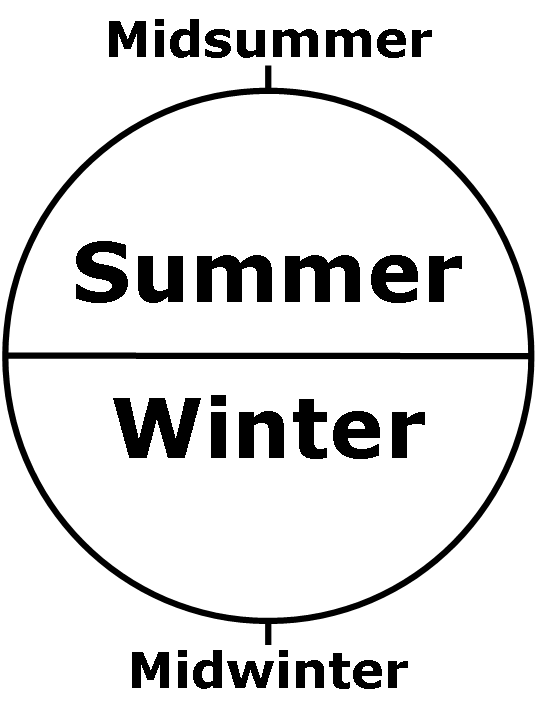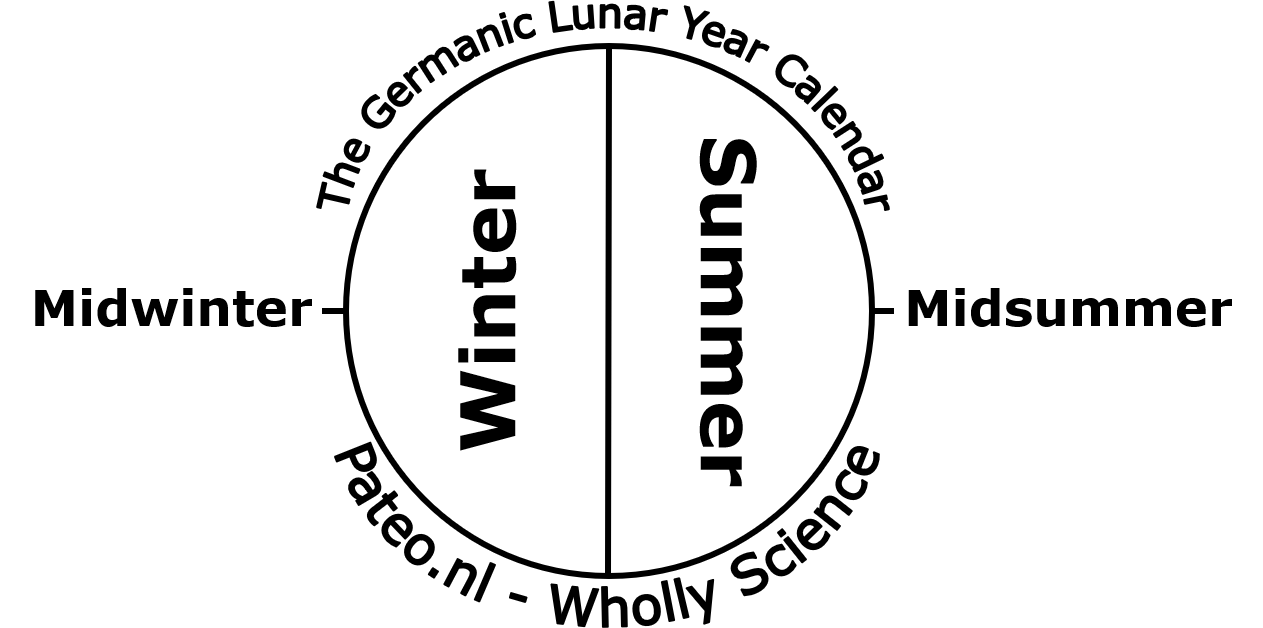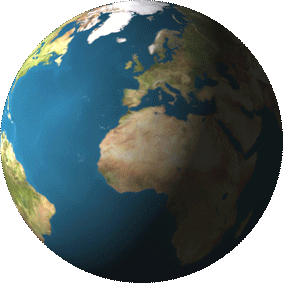Germanic Lunar Year Calendar
The word “month” comes from “moon”. But our months do not correspond to the period from new moon to the next new moon. This is however the case with the Germanic Lunar Year Calendar. The first day of each lunar period (or “Monath”) is always the new moon day, and the fifteenth day (or shortly after) is always full moon day.
Within Wholly Science, the moon that orbits our home planet named Terra is referred to as Luna. As the current Gregorian calendar hinders us to become aware of the impact of Luna, Wholly Science reinstated the Germanic Lunar Year Calendar. The overview below also indicates the beginning of each subsequent lunar year (which is usually called the Chinese New Year).
 |
The ancient Germanic people divided the year into two halves: Summer and Winter. Precisely in the middle of each half, a great celebration took place. The Midsummer Feast was named “Litha”, and the Midwinter Feast “Yule”. The lunar period in which this celebration falls has the designation of “Before” at the beginning of its name, and the next one has the designation of “After” at the beginning of its name.
Every third year has thirteen lunar periods instead of twelve, in order to correctly track both the solar and the lunar cycles. Wholly Science named this thirteenth lunar period as “Extra-Litha-Moon”. For the designation of the remaining eight lunar periods, Wholly Science remained as close as possible to the authentic Germanic names:
|
- After-Litha-Moon
- Aran-Moon
- Witu-Moon (last lunar period of the summer half)
- Windume-Moon (first lunar period of the winter half)
- Gor-Moon
- Before-Yule-Moon
- After-Yule-Moon
- Horning-Moon
- Rhetha-Moon (last lunar period of the winter half)
- Eostre-Moon (first lunar period of the summer half)
- Winni-Moon
- Before-Litha-Moon
- Extra-Litha-Moon
|
Next to these pure “moonths” (or months), Wholly Science also clarifies the names of the days of the week:
- Luna-day
- Mars-day
- Mercury-day
- Jupiter-day
- Venus-day
- Saturn-day
- Helios-day
|
Today’s date according to the Germanic Lunar Year Calendar is Jupiter-day, 5 Winni-Moon.
Overview
Below, the starting date of every next lunar period is listed, starting with the last one of the year 2016.
- 2016/12/29: After-Yule-Moon (30), Full on 15th (2017/01/12)
- 2017/01/28: Horning-Moon (29), Full on 15th (2017/02/11) [start of the year of the fiery Rooster]
- 2017/02/26: Rhetha-Moon (30), Full on 15th (2017/03/12)
- 2017/03/28: Eostre-Moon (29), Full on 15th (2017/04/11)
- 2017/04/26: Winni-Moon (29), Full on 15th (2017/05/10)
- 2017/05/25: Before-Litha-Moon (30), Full on 16th (2017/06/09)
- 2017/06/24: Extra-Litha-Moon (29), Full on 16th (2017/07/09)
- 2017/07/23: After-Litha-Moon (29), Full on 16th (2017/08/07)
- 2017/08/21: Aran-Moon (30), Full on 17th (2017/09/06)
- 2017/09/20: Witu-Moon (29), Full on 16th (2017/10/05)
- 2017/10/19: Windume-Moon (30), Full on 17th (2017/11/04)
- 2017/11/18: Gor-Moon (30), Full on 16th (2017/12/03)
- 2017/12/18: Before-Yule-Moon (30), Full on 16th (2018/01/02)
- 2018/01/17: After-Yule-Moon (29), Full on 15th (2018/01/31)
- 2018/02/15: Horning-Moon (30), Full on 16th (2018/03/02) [start of the year of the earthen Dog]
- 2018/03/17: Rhetha-Moon (30), Full on 15th (2018/03/31)
- 2018/04/16: Eostre-Moon (29), Full on 15th (2018/04/30)
- 2018/05/15: Winni-Moon (29), Full on 15th (2018/05/29)
- 2018/06/13: Before-Litha-Moon (30), Full on 16th (2018/06/28)
- 2018/07/13: After-Litha-Moon (29), Full on 15th (2018/07/27)
- 2018/08/11: Aran-Moon (29), Full on 16th (2018/08/26)
- 2018/09/09: Witu-Moon (30), Full on 17th (2018/09/25)
- 2018/10/09: Windume-Moon (29), Full on 16th (2018/10/24)
- 2018/11/07: Gor-Moon (30), Full on 17th (2018/11/23)
- 2018/12/07: Before-Yule-Moon (30), Full on 16th (2018/12/22)
- 2019/01/06: After-Yule-Moon (29), Full on 16th (2019/01/21)
- 2019/02/04: Horning-Moon (30), Full on 16th (2019/03/19) [start of the year of the earthen Pig]
- 2019/03/06: Rhetha-Moon (30), Full on 16th (2019/03/21)
- 2019/04/05: Eostre-Moon (30), Full on 15th (2019/04/19)
- 2019/05/05: Winni-Moon (29), Full on 14th (2019/05/18)
- 2019/06/03: Before-Litha-Moon (29), Full on 15th (2019/06/17)
- 2019/07/02: After-Litha-Moon (30), Full on 15th (2019/07/16)
- 2019/08/01: Aran-Moon (29), Full on 15th (2019/08/15)
- 2019/08/30: Witu-Moon (29), Full on 16th (2019/09/14)
- 2019/09/28: Windume-Moon (30), Full on 16th (2019/10/13)
- 2019/10/28: Gor-Moon (29), Full on 17th (2019/11/12)
- 2019/11/26: Before-Yule-Moon (30), Full on 17th (2019/12/12)
- 2019/12/26: After-Yule-Moon (30), Full on 16th (2020/01/10)
- 2020/01/24: Horning-Moon (30), Full on 17th (2020/02/09) [start of the year of the metallic Rat]
- 2020/02/23: Rhetha-Moon (30), Full on 16th (2020/03/09)
- 2020/03/24: Eostre-Moon (30), Full on 16th (2020/04/08)
- 2020/04/23: Winni-Moon (29), Full on 15th (2020/05/07)
- 2020/05/22: Before-Litha-Moon (30), Full on 15th (2020/06/05)
- 2020/06/21: Extra-Litha-Moon (29), Full on 15th (2020/07/05)
- 2020/07/20: After-Litha-Moon (30), Full on 15th (2020/08/03)
- 2020/08/19: Aran-Moon (29), Full on 15th (2020/09/02)
- 2020/09/17: Witu-Moon (29), Full on 15th (2020/10/01)
- 2020/10/16: Windume-Moon (30), Full on 16th (2020/10/31)
- 2020/11/15: Gor-Moon (29), Full on 16th (2020/11/30)
- 2020/12/14: Before-Yule-Moon (30), Full on 17th (2020/12/30)
- 2021/01/13: After-Yule-Moon (29), Full on 16th (2021/01/28)
- 2021/02/11: Horning-Moon (30), Full on 17th (2021/02/27) [start of the year of the metallic Ox]
- 2021/03/13: Rhetha-Moon (30), Full on 16th (2021/03/28)
- 2021/04/12: Eostre-Moon (29), Full on 16th (2021/04/27)
- 2021/05/11: Winni-Moon (30), Full on 16th (2021/05/26)
- 2021/06/10: Before-Litha-Moon (30), Full on 15th (2021/06/24)
- 2021/07/10: After-Litha-Moon (29), Full on 15th (2021/07/24)
- 2021/08/08: Aran-Moon (30), Full on 15th (2021/08/22)
- 2021/09/07: Witu-Moon (29), Full on 14th (2021/09/20)
- 2021/10/06: Windume-Moon (29), Full on 15th (2021/10/20)
- 2021/11/04: Gor-Moon (30), Full on 16th (2021/11/19)
- 2021/12/04: Before-Yule-Moon (29), Full on 16th (2021/12/19)
- 2022/01/02: After-Yule-Moon (30), Full on 17th (2022/01/18)
- 2022/02/01: Horning-Moon (29), Full on 16th (2022/02/16) [start of the year of the watery Tiger]
- 2022/03/02: Rhetha-Moon (30), Full on 17th (2022/03/18)
- 2022/04/01: Eostre-Moon (29), Full on 16th (2022/04/16)
- 2022/04/30: Winni-Moon (30), Full on 17th (2022/05/16)
- 2022/05/30: Before-Litha-Moon (30), Full on 16th (2022/06/14)
- 2022/06/29: After-Litha-Moon (29), Full on 15th (2022/07/13)
- 2022/07/28: Aran-Moon (30), Full on 16th (2022/08/12)
- 2022/08/27: Witu-Moon (29), Full on 15th (2022/09/10)
- 2022/09/25: Windume-Moon (30), Full on 15th (2022/10/09)
- 2022/10/25: Gor-Moon (29), Full on 15th (2022/11/08)
- 2022/11/23: Before-Yule-Moon (30), Full on 16th (2022/12/08)
- 2022/12/23: After-Yule-Moon (29), Full on 16th (2023/01/07)
- 2023/01/21: Horning-Moon (30), Full on 16th (2023/02/05) [start of the year of the watery Rabbit]
- 2023/02/23: Rhetha-Moon (29), Full on 16th (2023/03/07)
- 2023/03/21: Eostre-Moon (30), Full on 17th (2023/04/06)
- 2023/04/20: Winni-Moon (29), Full on 16th (2023/05/05)
- 2023/05/19: Before-Litha-Moon (30), Full on 17th (2023/06/04)
- 2023/06/18: Extra-Litha-Moon (29), Full on 16th (2023/07/03)
- 2023/07/17: After-Litha-Moon (30), Full on 16th (2023/08/01)
- 2023/08/16: Aran-Moon (30), Full on 16th (2023/08/31)
- 2023/09/15: Witu-Moon (29), Full on 15th (2023/09/29)
- 2023/10/14: Windume-Moon (30), Full on 15th (2023/10/28)
- 2023/11/13: Gor-Moon (30), Full on 15th (2023/11/27)
- 2023/12/13: Before-Yule-Moon (29), Full on 15th (2023/12/27)
- 2024/01/11: After-Yule-Moon (30), Full on 15th (2024/01/25)
- 2024/02/10: Horning-Moon (29), Full on 15th (2024/02/24) [start of the year of the wooden Dragon]
- 2024/03/10: Rhetha-Moon (29), Full on 16th (2024/03/25)
- 2024/04/08: Eostre-Moon (30), Full on 17th (2024/04/24)
- 2024/05/08: Winni-Moon (29), Full on 16th (2024/05/23)
- 2024/06/06: Before-Litha-Moon (30), Full on 16th (2024/06/21)
- 2024/07/06: After-Litha-Moon (29), Full on 16th (2024/07/21)
- 2024/08/04: Aran-Moon (30), Full on 16th (2024/08/19)
- 2024/09/03: Witu-Moon (29), Full on 16th (2024/09/18)
- 2024/10/02: Windume-Moon (30), Full on 16th (2024/10/17)
- 2024/11/01: Gor-Moon (30), Full on 15th (2024/11/15)
- 2024/12/01: Before-Yule-Moon (29), Full on 15th (2024/12/15)
- 2024/12/30: After-Yule-Moon (30), Full on 15th (2025/01/13)
- 2025/01/29: Horning-Moon (30), Full on 15th (2025/02/12) [start of the year of the wooden Snake]
- 2025/02/28: Rhetha-Moon (29), Full on 15th (2025/03/14)
- 2025/03/29: Eostre-Moon (29), Full on 16th (2025/04/13)
- 2025/04/27: Winni-Moon (30), Full on 16th (2025/05/12)
- 2025/05/27: Before-Litha-Moon (29), Full on 16th (2025/06/11)
- 2025/06/25: After-Litha-Moon (29), Full on 16th (2025/07/10)
- 2025/07/24: Aran-Moon (30), Full on 17th (2025/08/09)
- 2025/08/23: Witu-Moon (29), Full on 16th (2025/09/07)
- 2025/09/21: Windume-Moon (30), Full on 17th (2025/10/07)
- 2025/10/21: Gor-Moon (30), Full on 16th (2025/11/05)
- 2025/11/20: Before-Yule-Moon (30), Full on 16th (2025/12/05)
- 2025/12/20: After-Yule-Moon (29), Full on 15th (2026/01/03)

This article on the Germanic Lunar Year Calendar by Johan Oldenkamp, originally written on 16 January 2017, is also available in
German,
Italian, and
Dutch.
© Pateo.NL : This page was last updated on 2024/12/29.







